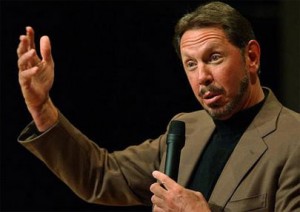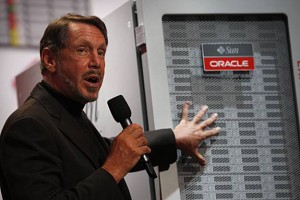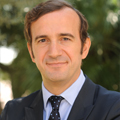 “Okay, so this evening I’m going to announce the Exalogic Elastic Compute Cloud or a cloud in a box. [..]. And this is the Exalogic machine, hardware and software engineered to work together to run all of your applications, allow you to develop the applications then run the applications.” This statement could be one of many delivered by a technology company during a product presentation. However, that statement was part of this year opening keynote of the Oracle Open World, delivered by Larry Ellison, Oracle CEO. In mid-1970s, Larry Ellison together with Bob Miner and Ed Oates began working on a database project for the CIA with the code name: Oracle. The project was unfinished, but it was the origin of Oracle Corporation, one of the most powerful enterprise software companies in the world, after Microsoft and IBM. In the fiscal year 2010, Oracle had almost $27 billion in revenue, a net income of more than $6 billion, 370,000 customers, 20,000 partners, 104,500 employees and $3.3 billion invested in R&D. This impressive track record has been achieved by specializing in developing and marketing enterprise software products, particularly database management systems and enterprise applications like ERP, CRM, HCM and SCM. As a matter of fact, 77% of Oracle’s revenue in fiscal year 2010 came from software, 14% from associated services, and only 9% from hardware. Due to this reason, the announcement of a new hardware product as the main theme of Oracle’s keynote was signaling an important message how Oracle is going to reposition itself in the enterprise IT value chain.
“Okay, so this evening I’m going to announce the Exalogic Elastic Compute Cloud or a cloud in a box. [..]. And this is the Exalogic machine, hardware and software engineered to work together to run all of your applications, allow you to develop the applications then run the applications.” This statement could be one of many delivered by a technology company during a product presentation. However, that statement was part of this year opening keynote of the Oracle Open World, delivered by Larry Ellison, Oracle CEO. In mid-1970s, Larry Ellison together with Bob Miner and Ed Oates began working on a database project for the CIA with the code name: Oracle. The project was unfinished, but it was the origin of Oracle Corporation, one of the most powerful enterprise software companies in the world, after Microsoft and IBM. In the fiscal year 2010, Oracle had almost $27 billion in revenue, a net income of more than $6 billion, 370,000 customers, 20,000 partners, 104,500 employees and $3.3 billion invested in R&D. This impressive track record has been achieved by specializing in developing and marketing enterprise software products, particularly database management systems and enterprise applications like ERP, CRM, HCM and SCM. As a matter of fact, 77% of Oracle’s revenue in fiscal year 2010 came from software, 14% from associated services, and only 9% from hardware. Due to this reason, the announcement of a new hardware product as the main theme of Oracle’s keynote was signaling an important message how Oracle is going to reposition itself in the enterprise IT value chain.
A change that was undoubtedly reflected in the event tag line: “Hardware and Software engineered to work together”. Last week Oracle Open World, which was held at the Moscone Center in San Francisco, was the first after the acquisition of Sun Microsystems this last January. Oracle is noteworthy for a long tradition of acquisitions among others BEA Systems, Hyperion Corporation, Siebel Systems, and PeopleSoft. The majority of Oracle’s acquisitions have been in the area of enterprise software. Their underlying philosophy has been to complement their product offerings and at the same time achieve scale efficiencies by consolidation of products, services and processes. To that extent, Oracle has followed a horizontal market approach. On one hand, Oracle’s flagship product, the database, is interoperating with their own enterprise applications, as well as, competitors like SAP. On the other hand, the software is running on third party hardware vendors such as IBM, HP or DELL.
 A lot of expectation was built before the opening keynote. Not only because it was the largest Oracle’s event ever, with 41,000 attendees of 116 countries, including JavaOne, the former Sun Microsystems conference for Java developers; but also for the latest developments at the corporate level. First, HP, the main partner of Oracle, was suing Mark Hurd, HP’s ousted CEO, over hiring by Oracle as its President. Second, Oracle recently sued Google, accusing it of copyright and patent infringement by using Java code in Android mobile OS (see previous post). However, neither of these two issues were addressed in any of the Oracle’s keynotes. Moreover, HP and Oracle buried the hatchet and HP dropped the lawsuit against Mark Hurd. Too much is at stake with 140,000 joint customers and 40% of Oracle’s licenses running on HP machines, as Ann Livermore, Executive Vice President for HP Enterprise Business, highlighted in her keynote just before Larry Ellison’s. In addition, Thomas Kurian, Oracle Executive Vice President for Product, tried to calm the waters over the Google lawsuit during an executive panel Q&A, where he stated: “The model for Java has always been that we give customers and the developer community [access to] open source Java and we also license it to commercial vendors under the standard license process”.
A lot of expectation was built before the opening keynote. Not only because it was the largest Oracle’s event ever, with 41,000 attendees of 116 countries, including JavaOne, the former Sun Microsystems conference for Java developers; but also for the latest developments at the corporate level. First, HP, the main partner of Oracle, was suing Mark Hurd, HP’s ousted CEO, over hiring by Oracle as its President. Second, Oracle recently sued Google, accusing it of copyright and patent infringement by using Java code in Android mobile OS (see previous post). However, neither of these two issues were addressed in any of the Oracle’s keynotes. Moreover, HP and Oracle buried the hatchet and HP dropped the lawsuit against Mark Hurd. Too much is at stake with 140,000 joint customers and 40% of Oracle’s licenses running on HP machines, as Ann Livermore, Executive Vice President for HP Enterprise Business, highlighted in her keynote just before Larry Ellison’s. In addition, Thomas Kurian, Oracle Executive Vice President for Product, tried to calm the waters over the Google lawsuit during an executive panel Q&A, where he stated: “The model for Java has always been that we give customers and the developer community [access to] open source Java and we also license it to commercial vendors under the standard license process”.
However, Larry Ellison put out all the stops unveiling five new Oracle products. First, Fusion Applications a new consolidated enterprise software, which is the result of a five-year development project. The whole idea is to re-implement all features of PeopleSoft, Siebel, JD Edwards and Oracle on top of a modern middleware based on Java. In words of Larry Ellison, Fusion Applications are business intelligence driven applications. That is to say, it is not only about the automatization of a process (e.g. to make a purchase) rather than to have an insight of the process (e.g. should I approve a purchase?). Interestingly enough, the other four products were all them related to hardware: the new SPARC-3 16-core processor, Exadata or intelligence in the storage for data warehouses, and the unbreakable enterprise kernel for Oracle Linux or an improved version of RedHat that is optimized for Oracle hardware and software.
 Last but not least, the Exalogic Elastic Cloud or Oracle Exalogic Elastic Cloud or Oracle’s answer to cloud computing: “cloud in a box” . A virtualized datacenter in one single rack. It includes 30 servers with a total of 360 cores, a 40Gb/sec InfiniBand network interconnecting the servers and 3TB of DRAM with 40TB of storage. Oracle also claims a staggering performance; the Exalogic box ($1 million a piece) is capable of one million HTTP requests per second. In other words, two Exalogic boxes side by side could do Facebook globally!
Last but not least, the Exalogic Elastic Cloud or Oracle Exalogic Elastic Cloud or Oracle’s answer to cloud computing: “cloud in a box” . A virtualized datacenter in one single rack. It includes 30 servers with a total of 360 cores, a 40Gb/sec InfiniBand network interconnecting the servers and 3TB of DRAM with 40TB of storage. Oracle also claims a staggering performance; the Exalogic box ($1 million a piece) is capable of one million HTTP requests per second. In other words, two Exalogic boxes side by side could do Facebook globally!
Only two years ago, Ellison said in the same event that the computer industry is more fashion-driven than women’s fashion and cloud computing is simply the latest fashion and complete gibberish. Today cloud computing for Oracle, it is not any more a question of fashion but a fundamental pillar in their strategy. Nevertheless, Oracle stresses that cloud computing should be equivalent to a virtualized and an elastic platform like Amazon EC2. In contrast, Larry Ellison defined Salesforce.com, sponsoring the event, as a mere application on the Internet with no virtualization and elastic capacity. This definition created a controversy between Mark Benioff, CEO of Salesforce.com, and Larry Ellison, who parodied each other in different keynotes. Beyond semantic issues, Oracle is betting in building and managing a private cloud through an on-premise virtualized infrastructure. The main difference lies in the business model. While an on-premise virtualized infrastructure translates into a fixed cost, a public virtualized multi-tenancy infrastructure allows a pay per use scheme.
In a nutshell, Oracle is the new player in the datacenter hardware, competing in the same league with their current partners IBM and HP. With a complete software and hardware solution, Oracle is clearly favoring a vertical integration. In Larry Ellison’s words: “If you engineer the pieces together, it is a better and reliable product. Like the iPhone.” Ellison is a good friend of Steve Jobs and both of them seem to share the quote by Alan Kay, American computer scientist, which Jobs referred while unveiling the iPhone in 2007: “People who are really serious about software should make their own hardware”. However, it remains to be seen how current partners are going to react to this approach and if customers will be willing to lock-in and invest in a 100% Oracle platform. The message is clear. Just in case, Larry Ellison himself delivered twice the same keynote in to different days. Ellison knows how to sail in adverse weather conditions, as it was shown in the video of Oracle-BMW sailboat winning the America’s Cup. There is no doubt that when you put a cloud in a box, you have a chance of thunderstorms.


